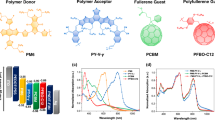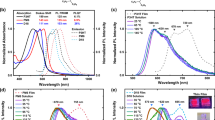Abstract
The recombination of electrons and holes in semiconducting polymer–fullerene blends has been identified as a main cause of energy loss in organic photovoltaic devices. Generally, an external bias voltage is required to efficiently separate the electrons and holes and thus prevent their recombination. Here we show that a large, permanent, internal electric field can be ensured by incorporating a ferroelectric polymer layer into the device, which eliminates the need for an external bias. The electric field, of the order of 50 V μm−1, potentially induced by the ferroelectric layer is tens of times larger than that achievable by the use of electrodes with different work functions. We show that ferroelectric polymer layers enhanced the efficiency of several types of organic photovoltaic device from 1–2% without layers to 4–5% with layers. These enhanced efficiencies are 10–20% higher than those achieved by other methods, such as morphology and electrode work-function optimization. The devices show the unique characteristics of ferroelectric photovoltaic devices with switchable diode polarity and tunable efficiency.
This is a preview of subscription content, access via your institution
Access options
Subscribe to this journal
Receive 12 print issues and online access
$259.00 per year
only $21.58 per issue
Buy this article
- Purchase on SpringerLink
- Instant access to full article PDF
Prices may be subject to local taxes which are calculated during checkout




Similar content being viewed by others
References
Yu, G., Gao, J., Hummelen, J. C., Wudl, F. & Heeger, A. J. Polymer photovoltaic cells: Enhanced efficiencies via a network of internal donor–acceptor heterojunctions. Science 270, 1789–1791 (1995).
Sariciftci, N. S., Smilowitz, L., Heeger, A. J. & Wudl, F. Photoinduced electron transfer from a conducting polymer to buckminsterfullerene. Science 258, 1474–1476 (1992).
Chen, H. Y. et al. Polymer solar cells with enhanced open-circuit voltage and efficiency. Nature Photon. 3, 649–653 (2009).
Park, S. H. et al. Bulk heterojunction solar cells with internal quantum efficiency approaching 100%. Nature Photon. 3, 297–303 (2009).
Liang, Y. et al. For the bright future—bulk heterojunction polymer solar cells with power conversion efficiency of 7.4%. Adv. Mater. 22, 1–4 (2010).
Kim, J. Y. et al. Efficient tandem polymer solar cells fabricated by all-solution processing. Science 317, 222–225 (2007).
Chen, H-Y. et al. Silicon atom substitution enhances interchain packing in a thiophene-based polymer system. Adv. Mater. 21, 1–5 (2009).
Liang, Y. Y. et al. Development of new semiconducting polymers for high performance solar cells. J. Am. Chem. Soc. 131, 56–57 (2009).
Liang, Y. Y. et al. Highly efficient solar cell polymers developed via fine-tuning of structural and electronic properties. J. Am. Chem. Soc. 131, 7792–7799 (2009).
Veldman, D., Meskers, S. C. J. & Janssen, R. A. J. The energy of charge-transfer states in electron donor–acceptor blends: Insight into the energy losses in organic solar cells. Adv. Funct. Mater. 19, 1939–1948 (2009).
Kirchartz, T., Taretto, K. & Rau, U. Efficiency limits of organic bulk heterojunction solar cells. J. Phys. Chem. C 113, 17958–17966 (2009).
Veldman, D. et al. Compositional and electric field dependence of the dissociation of charge transfer excitons in alternating polyfluorene copolymer/fullerene blends. J. Am. Chem. Soc. 130, 7721–7735 (2008).
Vandewal, K., Tvingstedt, K., Gadisa, A., Inganäs, O. & Manca, J. V. On the origin of the open-circuit voltage of polymer–fullerene solar cells. Nature Mater. 8, 904–909 (2009).
Shrotriya, V., Yao, Y., Li, G. & Yang, Y. Effect of self-organization in polymer/fullerene bulk heterojunctions on solar cell performance. Appl. Phys. Lett. 89, 063505 (2006).
Brabec, C. J. et al. Origin of the open circuit voltage of plastic solar cells. Adv. Funct. Mater. 11, 374–380 (2001).
Gadisa, A., Svensson, M., Andersson, M. R. & Inganas, O. Correlation between oxidation potential and open-circuit voltage of composite solar cells based on blends of polythiophenes/fullerene derivative. Appl. Phys. Lett. 84, 1609–1611 (2004).
Cravino, A. Origin of the open circuit voltage of donor–acceptor solar cells: Do polaronic energy levels play a role? Appl. Phys. Lett. 91, 243502 (2007).
Cremer, J., Bauerle, P., Wienk, M. M. & Janssen, R. A. J. High open-circuit voltage poly(ethynylene bithienylene): Fullerene solar cells. Chem. Mater. 18, 5832–5834 (2006).
Roquet, S. et al. Triphenylamine–thienylenevinylene hybrid systems with internal charge transfer as donor materials for heterojunction solar cells. J. Am. Chem. Soc. 128, 3459–3466 (2006).
Mutolo, K. L., Mayo, E. I., Rand, B. P., Forrest, S. R. & Thompson, M. E. Enhanced open-circuit voltage in subphthalocyanine/C-60 organic photovoltaic cells. J. Am. Chem. Soc. 128, 8108–8109 (2006).
Scharber, M. C. et al. Design rules for donors in bulk-heterojunction solar cells—towards 10% energy-conversion efficiency. Adv. Mater. 18, 789–794 (2006).
Rand, B. P., Burk, D. P. & Forrest, S. R. Offset energies at organic semiconductor heterojunctions and their influence on the open-circuit voltage of thin-film solar cells. Phys. Rev. B 75, 115327–115337 (2007).
Schueppel, R. et al. Optimizing organic photovoltaics using tailored heterojunctions: A photoinduced absorption study of oligothiophenes with low band gaps. Phys. Rev. B 77, 085311–085324 (2008).
Tvingstedt, K. et al. Electroluminescence from charge transfer states in polymer solar cells. J. Am. Chem. Soc. 131, 11819–11824 (2009).
Shockley, W. & Queisser, H. Detailed balance limit of efficiency of p–n junction solar cells. J. Appl. Phys. 32, 510–519 (1961).
Veldman, D. et al. Compositional and electric field dependence of the dissociation of charge transfer excitons in alternating polyfluorene copolymer/fullerene blends. J. Am. Chem. Soc. 130, 7721–7735 (2008).
Mihailetchi, V. D., Koster, L. J. A., Hummelen, J. C. & Blom, P. W. M. Photocurrent generation in polymer–fullerene bulk heterojunctions. Phys. Rev. Lett. 93, 216601–216604 (2004).
Braun, C. L. Electric field assisted dissociation of charge transfer states as a mechanism of photocarrier production. J. Chem. Phys. 80, 4157–4161 (1984).
Onsager, L. Deviations from ohm’s law in weak electrolytes. J. Chem. Phys. 2, 599–615 (1934).
Kim, J. Y. et al. New architecture for high-efficiency polymer photovoltaic cells using solution-based titanium oxide as an optical spacer. Adv. Mater. 18, 572–576 (2006).
Furukawa, T. Ferroelectric properties of vinylidene fluoride copolymers. Phase Transit. 18, 143–211 (1989).
Bune, A. V. et al. Two-dimensional ferroelectric films. Nature 391, 874–877 (1998).
Ducharme, S., Palto, S. P., Blinov, L. M. & Fridkin, V. M. Physics of two-dimensional ferroelectric polymers. AIP Conf. Proc. 535, 354–363 (2000).
Junquera, J. & Ghosez, P. Critical thickness for ferroelectricity in perovskite ultrathin films. Nature 422, 506–509 (2003).
Ahn, C. H., Rabe, K. M. & Triscone, J. M. Ferroelectricity at the nanoscale: Local polarization in oxide thin films and heterostructures. Science 303, 488–491 (2004).
Hou, J. H., Chen, H. Y., Zhang, S. Q., Li, G. & Yang, Y. Synthesis, characterization, and photovoltaic properties of a low band gap polymer based on silole-containing polythiophenes and 2,1,3-benzothiadiazole. J. Am. Chem. Soc. 130, 16144–16145 (2008).
Sorokin, A. V., Bai, M., Ducharme, S. & Poulsen, M. Langmuir–Blodgett films of polyethylene. J. Appl. Phys. 92, 5977–5981 (2002).
Zhuravlev, M. Y., Sabirianov, R. F., Jaswal, S. S. & Tsymbal, E. Y. Giant electroresistance in ferroelectric tunnel junctions. Phys. Rev. Lett. 94, 246802 (2005).
Li, N., Lassiter, B. E., Lunt, R. R., Wei, G. & Forrest, S. R. Open circuit voltage enhancement due to reduced dark current in small molecule photovoltaic cells. Appl. Phys. Lett. 94, 023307 (2009).
Potscavage, W. J., Yoo, S. & Kippelen, B. Origin of the open-circuit voltage in multilayer heterojunction organic solar cells. Appl. Phys. Lett. 93, 193308 (2008).
Liang, Y. et al. Development of new semiconducting polymers for high performance solar cells. J. Am. Chem. Soc. 131, 56–57 (2008).
Sista, S., Hong, Z. R., Park, M. H., Xu, Z. & Yang, Y. High-efficiency polymer tandem solar cells with three-terminal structure. Adv. Mater. 22, E77–E80 (2010).
Sista, S. et al. Highly efficient tandem polymer photovoltaic cells. Adv. Mater. 22, 380–383 (2010).
Bai, M. J. & Ducharme, S. Ferroelectric nanomesa formation from polymer Langmuir–Blodgett films. Appl. Phys. Lett. 85, 3528–3530 (2004).
Duan, C. G., Sabirianov, R. F., Mei, W. N., Jaswal, S. S. & Tsymbal, E. Y. Interface effect on ferroelectricity at the nanoscale. Nano Lett. 6, 483–487 (2006).
Chen, X. Q., Yamada, H., Horiuchi, T. & Matsushige, K. Investigation of surface potential of ferroelectric organic molecules by scanning probe microscopy. Jpn. J. Appl. Phys. Part 1 38, 3932–3935 (1999).
Qin, M., Yao, K. & Liang, Y. C. High efficient photovoltaics in nanoscaled ferroelectric thin films. Appl. Phys. Lett. 93, 122904 (2008).
Ducharme, S., Palto, S. P. & Fridkin, V. M. in Ferroelectric and Dielectric Thin Films (ed. Nalwa, H. S.) 545–591 (Academic, 2002).
Acknowledgements
S.D. thanks the Nebraska Research Initiative and the National Science Foundation Materials Research Science and Engineering Center for financial support (DMR-0820521). A.G. acknowledges financial support from the US Department of Energy, Office of Basic Energy Sciences, Division of Materials Sciences and Engineering under award DE-SC0004530.
Author information
Authors and Affiliations
Contributions
J.H. conceived the idea. J.H. and Y. Yuan designed the experiments. Y. Yuan carried out the fabrication of photovoltaic devices, the current–voltage measurement, the AFM and electrostatic force microscopy measurements and data analysis. Y. Yuan constructed the model. T.J.R., S.P. and S.D. carried out the deposition of P(VDF-TrFE) LB film and capacitance measurement. P.S. and A.G. were responsible for the PFM and conducting AFM measurement. Y. Yang provided the PSBTBT polymer. Y. Yuan, J.H., T.J.R. and S.D. analysed the data. J.H. and Y. Yuan wrote the paper. S.D. reviewed and commented on the paper.
Corresponding author
Ethics declarations
Competing interests
The authors declare no competing financial interests.
Supplementary information
Rights and permissions
About this article
Cite this article
Yuan, Y., Reece, T., Sharma, P. et al. Efficiency enhancement in organic solar cells with ferroelectric polymers. Nature Mater 10, 296–302 (2011). https://doi.org/10.1038/nmat2951
Received:
Accepted:
Published:
Issue Date:
DOI: https://doi.org/10.1038/nmat2951



